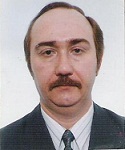
Plenary Lecture
Pecularities of the Electromagnetically and Vibrationally Controlled Film Flows

Professor Ivan Kazachkov
Energy Technology Dept.
Royal Institute of Technology (KTH)
Sweden
&
Head of Department of Applied Mathematics and Informatics
Nizhyn State University
Ukraine
E:mail: Ivan.Kazachkov@energy.kth.se
Abstract: Problems of parametric excitation and suppression of oscillations of a film surface at strong action of the inertia forces are considered theoretically and in a wide range of applications (fast-moving films represent the new, earlier almost unstudied class of flows with free boundaries). Mathematical models obtained allowed studying the peculiarities of the film flows affected by electromagnetic field and vibrations. The results obtained may be of interest for granulation machines and another application and allow predicting reaction of the interfacial boundary of media to parametric influence. The following regularities of the new class of film flows have been determined:
- in case of plainly spreading film flows the superficial waves are practically undispersiv, whereas radially spreading are significantly dispersing by ;
- in radially spreading film flow the phase and group speeds of the superficial and electromagnetic waves, in a contrast to the plainly spreading film flows, don't coincide that makes essential difference of two types of films and causes difficulties of parametric excitation of oscillations on a surface of radially spreading films of the set type. The non-linear oscillations revealed the next features:
- in case of long-wave fluctuations of a film surface an energy of unperturbed flow is pumped into a kinematic wave via the wave mechanism of the highest order; thus excitement of dynamic waves demands an electromagnetic field of high intensity. Gravitational and viscous forces promote a pumping of film perturbations;
- capillary waves are defined by Weber and Alfwen criteria and a type of an electromagnetic field or vibrations due to which there is a pumping of perturbations. Viscous forces do not play essential role defining only pulsations of wave fronts;
- the soliton type solutions for vibration excitation of oscillations on a film surface, unlike electromagnetic, are absent, though the equation describing evolution of a film surface contains derivatives of the corresponding terms of KDV;
- at big vibro-overloads (vibrational acceleration comparing to gravitational acceleration, Vibrational Euler number ) the process is described by the modified Burgers equation, i.e. available appearance of shock waves on a film flow; similar process on radially spreading film flow differs by special complexity;
- the condition of a vibro-dispersing was defined, i.e. separation of drops from a film surface at excess of critical value of a vibro-overload when the package of kinematic waves on a film surface turns into system of the separate small jets, which are generators of drops; as all small jets are nearly identical owing to constancy of length of standing or kinematic waves, disintegration of a film happens with narrow dispersive distribution. Especially - in case of a parametric resonance of the system.
Brief Biography of the Speaker: Ivan V. Kazachkov is Mechanical Engineer who had earned his PhD (Candidate of Physical and Mathematical Sciences, 1981) and MSc (1976) from the Kyiv National T. Shevchenko University. He got Full Doctorship (1991) in Engineering Sciences from the Institute of Physics of the Latvian Academy of Sciences in Riga. He became Full Professor at the Institute of Electrodynamics of the National Ukrainian Academy of Sciences since 1989, after 1995 he has been Head of Dept and Principal Investigator at the State scienfifc and Technical Center on Nuclear and Radiation Safety of Ukraine. During 1998-2004 Ivan Kazachkov has worked at the KTH, Energy Technology Dept as Guest Professor, then during 5 years was teaching and doing research at the National Technical Univeristy of Ukraine “KPI” continuing his work part-time as Visiting Professor at KTH, teaching numerical methods and doing research in modeling of multiphase systems. Since 2008 till present time he is Affiliated Professor at the KTH. Since 2009 Prof. Kazachkov is Head of Department of Applied Mathematics and Informatics at the Nizhyn State University named after M. Gogol, during 2010-2012 was also part-time Head of Dept on Energy Saving and Heat Power at the Ukrainian Academy of Civil-Communal Economy in Kyiv. The research activities of Prof. Kazachkov include Parametric Control in Continua, Multiphase Flows, Controlled Film Flow Decay, and Granulation of Metals for Special Metallurgy, Modeling and Simulation. He has over 200 publications in scientific journals and conferences, 5 patents, 10 monographs and lecture notes. He participates in the European research programs and committees. Five PhDs have defeded their dissertation under his supervision and a number of PhD students is doing research presently under his supervision.